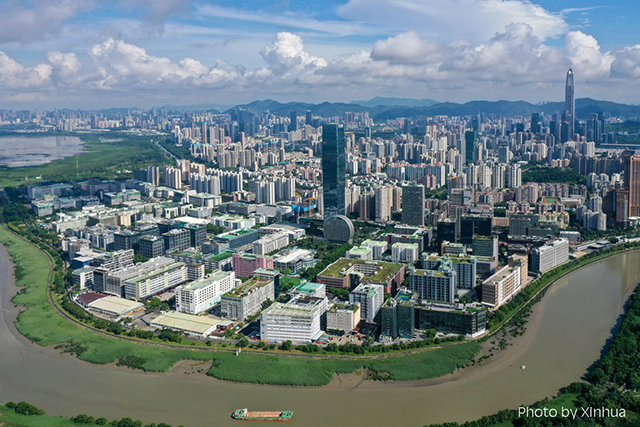



▲ An overview of the Hetao Shenzhen-Hong Kong Science and Technology Innovation Cooperation Zone in Shenzhen, Guangdong province. [Xinhua]
3. Main Contents.
3.3 Adhering to the innovation-driven development strategy, creating a high-quality development hub.
Firstly, accelerate the growth of new productive forces by promoting the high-quality development of the “20+8” strategic emerging industry clusters and future industries, and proactively plan new economies and business models to foster new growth drivers and competitive advantages. Secondly, leverage the Shenzhen High-Tech Industrial Park, the Shenzhen National Independent Innovation Demonstration Zone, and municipal-level emerging industry zones to form a "1+7+N" comprehensive innovation spatial layout. Thirdly, promote the consolidation of low-efficiency land and the adjustment of non-core and non-statutory land use, while focusing on integrated large-scale development. This will enhance the utilization of three-dimensional comprehensive spaces to ensure spatial support for modern industrial development.
3.4 Strengthen the integration of land and sea to promote the construction of a global ocean city.
Firstly, implement differentiated development strategies for the eastern and western sea areas to form a high-quality marine spatial layout. Use the coastal zone as a key development axis for the coupling of land and sea, and establish a "one belt, three zones, and fifteen segments" coastal spatial structure with the city and the sea intertwined. Secondly, differentiate protection strategies for uninhabited islands, focusing on protecting typical marine ecosystems. Thirdly, create emerging marine industry clusters, strengthen marine scientific research clusters, cultivate marine cultural brands, and work towards making Shenzhen a global ocean city.
3.5 Adhere to the people-centered approach and set up a benchmark for public well-being.
Firstly, focus on the "seven essentials of people's livelihood" by optimizing spaces for equitable, high-quality education facilities, universally accessible cultural and sports facilities, balanced healthcare resources, multi-tiered and diversified social welfare facilities, and comfortable, livable residential environments. Create 15-minute community life circles that are friendly to all ages, and establish a multi-level, diverse, full-coverage, and human-centered basic public service network. Secondly, build a comprehensive park system and make Shenzhen an international first-class park city that is vibrant and accessible to everyone. By 2035, the city will have over 1,500 parks, ensuring residents can access green open spaces in 5 minutes.
3.6 Prioritize ecology and promote a green and beautiful Shenzhen.
Firstly, strengthen the role of ecological green spaces and water systems in improving environmental quality, and create an overall ecological spatial structure of "four belts, eight zones, and multiple corridors." Improve the nature reserve system centered on nature reserves and natural parks. Secondly, vigorously promote the integration of forests into urban areas, the connection of water bodies throughout the city, and the blending of farmland with urban spaces, while coordinating the restoration of various ecological elements such as mountains, water bodies, forests, and oceans.
3.7 Strengthen infrastructure support capacity to build a connected and resilient city.
Firstly, enhance the aviation hubs’ capacity, optimize the ports’ functional layout, promote the construction of national and intercity railways, and improve the trans-Pearl River Estuary corridor system. This will establish Shenzhen as an internationally competitive comprehensive transportation hub with global reach and national influence. Secondly, build a resilient, efficient, green, and smart modern municipal infrastructure system, create a network for evacuation and rescue spaces, and comprehensively enhance the city's disaster prevention, relief, and mitigation capabilities to ensure safe urban operations.
3.8 Shape distinctive urban characteristics and highlight the charm of a modern city.
Firstly, strengthen the interweaving and blending characteristics of "mountains, sea, and city", and take the ecological framework of "one ridge, one belt, and twenty corridors" to shape Shenzhen’s multi-dimensional urban image as a "super bay metropolis, vibrant livable city, and poetic small city by the sea and mountains." Secondly, a heritage protection system should be established consisting of "immovable cultural relics, historical style areas, and historical buildings." This will deeply explore the cultural and historical sites of the reform and opening-up era, and create a cultural city that embraces diversity and harmonizes history with modernity.
3.9 Emphasize planning implementation to improve spatial governance.
Firstly, establish a "two-level, three-type" territorial planning system consisting of city and district-level master plans, detailed plans, and special plans to ensure planning is implemented at all levels and to strengthen the coordinated allocation of spatial resources. Secondly, improve the "one map" implementation supervision information system for territorial planning, and establish a monitoring, evaluation, and early warning mechanism to comprehensively enhance the capacity for territorial governance.
Source:
<https://www.sz.gov.cn/cn/xxgk/xwfyr/wqhg/20241010/>
Editor & Translator: GUO Xinxin